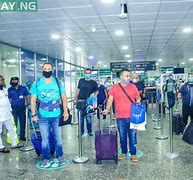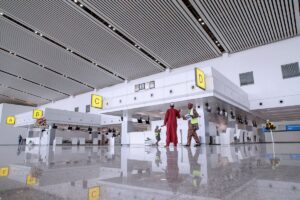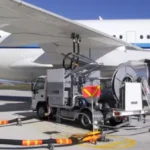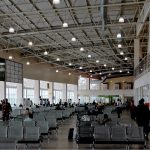
As continue to face disruptions and distress due to the relocation of airline operations from the old terminal to the new one. The writers says that although the new terminal was opened last year, the Federal Airports Authority of Nigeria did not evaluate the capacity in tandem with passenger traffic and airlines’ operations
On September 6, 2023, the Federal Airports Authority of Nigeria (FAAN) started the urgent relocation of international airlines from the Murtala Muhammed International Airport (MMIA), Lagos to the new one following the fire incident that affected the baggage management facilities of the old terminal.
Although the Minister of Aviation, Festus Keyamo, had directed that the foreign airlines should relocate to the new terminal by October 1, 2023, what would have become a gradual process became an emergency due to the fire incident.
Both the airlines and the passengers faced a lot of difficulty on the first three days of the relocation. Though the problem has not been completely solved, from all indications, FAAN has tamed the challenge.
Delays, Disruptions
There were a lot of disruptions in the first two days of the movement. The relocation started on a shaky start with many passengers missing their connecting flights as the majority of the airlines left Lagos late, including British Airways, Air France, KLM, and Qatar Airways, which left four hours beyond their schedule.
An airline official described the situation as chaotic because the new terminal had not been tested with such an upsurge in passenger movement to the extent that travellers found it difficult to identify the check-in counters of their airlines.
There were also baggage belt malfunctions at the new terminal, which exacerbated the passenger facilitation challenge.
THISDAY learnt that although the new terminal has state-of-the-art facilities, it is smaller than the old terminal and this caused congestion, forcing passengers to spill outside the terminal and travellers with many luggage found it difficult to move them to the checking in area.
Also, the facility has only one main entrance gate and passengers have to use escalators to climb to departures, which makes movement sluggish, especially during peak hours.
A FAAN official told THISDAY that the situation has improved because there was orderliness a fortnight ago and expressed the hope that the situation would get better.
“The airlines knew what to do but the terminal was small compared to the old one and that was why passenger processing was difficult, as check-in took longer time and some passengers found it difficult to locate their airlines.”
Capacity
But an industry stakeholder who had managed airports in other parts of the country said the new terminal has no capacity compared to the old and noted that this fact should have been taken into account by FAAN.
“You don’t just dream up these things. The ‘old’ terminal, launched in 1979, was designed with a capacity to process 1.5million passengers per annum. At full stretch, it would struggle to process three million passengers. Its peak hour processing capacity for both departing and arriving passengers was 1,200 passengers. So, its design service level was to provide comfortable processing for 1,200 departing and 1,200 arriving passengers at peak hours. These numbers informed the design of circulation space, check-in counters, toilet facilities, access and egress doors into and out of the terminal, the specifications of the baggage belt systems and arrival carousels (capacity and strength), the passenger security screening and customs/immigration capacity, any lifts and escalators, the scope and placement of commercial offerings and, of course, the access and egress road system as well as vehicle parking capacity,” the stakeholder said.
He excoriated the decision to build the terminal at the part of the airport where it is currently located, observing that the federal government did not respond in time to expand the terminal when there was a growing increase in passenger traffic stripping the capacity of the old terminal.
Architectural Design
The stakeholder who was an insider when the new terminal was built also said, “We briefed the same airport architects who had helped design Cape Town International’s 15 million passenger terminal (still adjudged the best on the continent until today) to do the conceptual design for a new, 12-airbridge, 9-million passenger, modularly expandable international terminal that was to be situated on the left side of the current (old) terminal. It was this conceptual design that we took to China Exim Bank and that they thoroughly interrogated and accepted before approving the facility they were to give us.
“But alas, we started building a terminal, totally different from the one we conceptually designed in the opposite location from where we were meant to build it (a story for another day). Unfortunately, every element of the basic terminal design stood on its head in the design of this terminal. The basic principles that inform terminal design from scratch, are: How many passengers are you designing a terminal for and for what purpose? Is the terminal being built for international, domestic, or both and is it to facilitate flight connections or just origin and destination traffic? These then determine how the key elements are designed, including how many contact and remote aircraft stands would be required and the accompanying circulation space, check-in capacity, security screening and customs/immigration capacity, toilet facilities, etc.

Concession
Reacting to the hiccups that trailed the relocation of airlines to the new terminal, aviation expert and the Managing Director of Centurion Security Services Limited, Group Captain John Ojikutu, said the federal government must get itself out of the direct involvement in commercial aviation and face squarely aeronautical safety and security services.
He said that the government must concession the MMIA’s two terminals without delay to help stop the “institutional corruption going on with the so-called repairs of the old terminal that has resulted in the fire in the building.”
“Remember that the domestic terminal that gave birth to the MMA2 was raised down completely by fire. This should be the selling point to the prospective investors and the political power that is in Abuja, especially in Aso Rock. Concession, privatisation, and commercialisation should not be stopped on the non-aeronautical services which mainly include the terminal buildings. Stop the institutional corruption in the civil aviation non-aeronautical services that are seriously affecting the safety and security services,” he said.
Gradual Movement
The Managing Director of Flight and Logistics Solutions Limited, Amos Akpan, told THISDAY that the emergency movement to the new terminal was not good, remarking that if the movement had been gradual it would not have faced the disruptions recorded in the first three days. He said that the decision to move to the new terminal shouldn’t have been directed by the minister but would have been a decision taken by FAAN management.
He said that the challenge is exacerbated by the fact that most of the foreign airlines arrive around the same time and take off around the same time which is usually in the night.
He suggested that there should be a review of the slot allocation, whereby some of the foreign airlines could be arriving in the mornings and in the afternoon, which are largely idle because many airlines do not fly to Nigeria during these periods, but the airport become very busy in the nights.
THISDAYLIVE.COM





